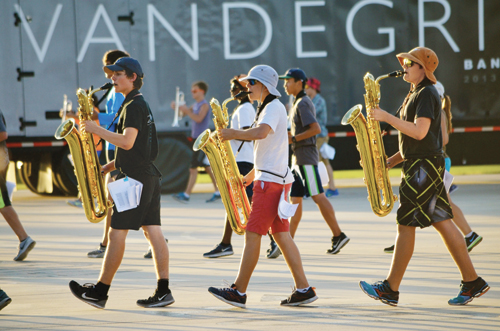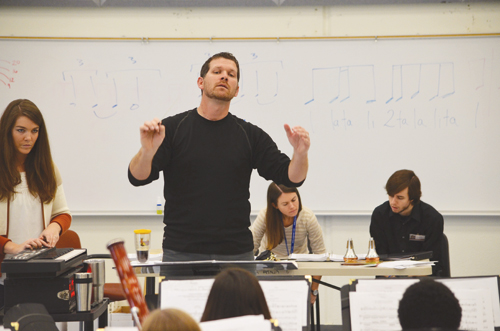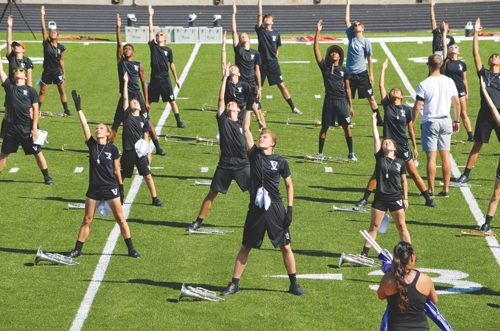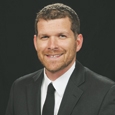
Mike Howard has witnessed dramatic growth and progress at Vandegrift High School in Austin, Texas, where he has taught since it opened in 2009. He expects the program to grow from 280 to 320 next school year. His bands have been consistent UIL Concert Contest Sweepstakes Awards Winners, TMEA State Honor Band Finalists, and, most recently, the UIL State Marching Contest State Silver Medalist. Now in his 13th year of teaching, Howard previously taught at James E. Taylor High School in Katy. For the past 10 years he has been a leadership consultant and workshop presenter for SASI. He is a graduate of Texas State University and lives in Cedar Park with his wife and two children.
How did you instill leadership at Vandegrift High School when it first opened?
As a new high school we did not have any experienced high school band members, so we asked some recent graduates in the area to help during the first few weeks of the initial marching season. That was the beginning of teaching our students how to lead and teach. Our student leadership team now has 50 members.
What exercises help to train student leaders?
We teach them the nuts and bolts of giving instruction. We discuss how and when to share information with students. As part of their training and audition process, prospective student leaders get to practice teaching students. We have 15-minute teaching units that allow staff members to observe students teaching their peers. We provide detailed feedback during that instructional period. At some schools, leadership auditions include mostly marching and performance skills, but we watch primarily to see how students interact with their peers. We want leaders who can consistently and effectively instruct their fellow students. As we continue training, many of our team-building exercises focus on how to give constructive feedback the right way.
What are the most common mistakes in these teaching labs?
The most common issues are fairly simple: speaking in a voice that is easily heard and understood and making eye contact with the group. Sometimes students have quite a bit of information to share, and try to say it all at the same time. We help them give quick, concise information. They tend to explain too much and lack effective communication skills. We tell students that the best way to overcome inexperience and nerves is through increased preparation. Once students get out of their shell and learn to make eye contact and speak loudly enough, the next big hiccup is identifying the single biggest problem and addressing one thing at a time.
Student instructors begin their training by working with more experienced students. That starts them in a comfortable setting. We move next to working with eighth-grade volunteers from our middle schools. These students know how to play instruments but know nothing about marching. That is where student leaders build their teaching vocabulary.
How do you use student leaders during the year?
The leadership team has 50 members for 280 students in the marching band and four concert bands. Everybody has a clear role. During marching season, we have three leadership roles. Our drum majors and drill instructors, provide instruction and feedback on the field. When we start the band season in the fall, those student leaders will receive daily goals. On the first day of summer band, all of my drill instructors and drum majors know that they are going to have 30 minutes to teach such concepts as posture or forward march. I always introduce the concept, but student instructors emphasize it with their sections. Those students have to turn in a lesson plan before they can teach that section on a given day. Each day in summer band, students know what their job will be in terms of a 15- or 30-minute lesson.
We have another group of leaders to handle logistics. We have a VP of logistics in charge of loading the truck, a VP of uniforms who runs the uniform room, a VP of communications who makes copies and manages social media messages.
Finally, we have section leaders who are musical leaders of our team. These are students listen to music pass-offs outside of rehearsals and conduct inspections before games and contests. They do not teach marching skills.
During concert season, the logistical jobs stay pretty much the same. Our drill instructors and section leaders move into a musical leadership role. Outside of rehearsal, they have certain expectations for their sections and for pass-offs. Section leaders preserve unity in each section during the transition from one large marching band to four concert bands. We want a trombone player in the fourth band to feel as much a part of the group as a lead player in the first band.
Students hold their leadership positions until April, and then we audition a new team that starts preparing for the upcoming marching season. Many groups have a leadership team that functions from August through October and then goes away. We try to have a full-year cycle that starts in April. Students have jobs and receive some type of training the whole time.
The band staff tell students that leadership is a skill, not just a talent. It can constantly improve. We have leadership sessions throughout the year. Some are done in house and others are activities like a ropes course or book studies. The SASI Student Leadership Curriculum is the springboard for our leadership training and the underlying model for our philosophy. We have also partnered with K & N Management, a company that owns a number of restaurants in Austin and proposed a joint leadership program with their managers and our student leaders. For the last four months we have participated in leadership training with the heads of various departments in the company. I suspect that many of our students will someday manage other people. This program lets them talk to people who already have those jobs.
How do section leaders help maintain unity during concert band season?
Social events are a big part of it. For many kids in the third and fourth band, music is a social outlet. They will work really hard, but do not expect to have a career in music. They want to be part of something bigger. They want a social group. We require one social event per month with the full instrument section. They may go bowling or play video games. Events at a nearby lake are also popular. It is a concrete way to have a section get along.
I talk to students in the wind ensemble and the symphonic band (the top two groups) and ask how many times they have met a player in the fourth band to play their music with them or talk. We want constant and consistent communication between players in different groups. Validation from older students means more to the younger players than anything I could ever say.
What do the new student leaders do at the end of the school year and during the summer?
The biggest responsibility is to connect and communicate with incoming eighth graders. We try to make the new students feel comfortable as quickly as possible. As with any program, we have eighth graders who are on the fence about continuing in music. The best tool for getting those kids in the door is the student leadership team.
A student-to-student discussion about the high school band program is much more valuable than one with a teacher. We have a night for students and parents who are new to the band program. It consists of two separate meetings that occur at the same time. Directors meet with parents and go through costs, trips, and logistics. Students attend a meeting led by the student leaders, who hold a question-and-answer session about band and high school in general with no adults present. They break up by section and have an icebreaker activity. Calming the fears of the new students is the first big project for the new student leaders.
In the summer there are training sessions. A couple of summers ago, students started turning social activities into training sessions. They get together at a park or someone’s house and hold an hour-long music or marching practice. Immediately following, they have some sort of fun activity. Right before marching starts up, we have a three-day training period to discuss our improvement strategies for all, staff included.
How far in advance do you set goals for your marching program?
The band staff starts planning summer band goals in June. We hold a marching band preview camp for three hours after school for a week in May. One objective is to learn the show opener and school songs. We want to get students excited about band. The staff can then set timelines for August, based on numbers, instrumentation, and ability. Our goal is to have a month free of band starting in late June or early July.
Once we return in the third week of July, we hold staff and student leadership meetings to map out our daily and weekly goals for the next month. For students we will specify in July when we want to learn everything. We create a production schedule, and students put it on a giant poster in the band hall. The staff takes that schedule and develops a daily schedule with our lessons for the next three or four weeks. We try to stay two weeks ahead on our planning.
For the first eight or nine years of my career, I created plans that were either completely unreasonable or too easy. It took quite some time to get to the point at which I could determine what could be done well in a given time. Thus, we talk frequently with students about flexibility in lesson plans.

What were your improvement goals this year?
One of my big goals for marching band was to further define marching techniques from player to player, something that was lacking last year. The foot placement and timing were pretty good, but the kids looked different from player to player moving across the field, specifically on backward technique. It was important get students looking better while moving backwards. The year before we played better than we looked. We flipped the coin and were almost stronger visually than we sounded.
I wanted the concert bands to improve at conveying musical ideas. We were technically proficient, but none of the groups were particularly musical. You think you sound musical until you listen to a recording. That is one reason I programmed Lincolnshire Posy this year. I knew Grainger would force us to play more musically. It is some of the most emotionally invested playing that we have ever done. Our goals influenced music selection for all four bands this year. We want to marry proficiency with musicality. Many ensembles are good at one but not both.
How do you work on developing musicality beyond the music selected?
First, the directors have to commit to professional development. After I pick my program, I consult with people who know that music really well. We are fortunate to have people nearby with great wisdom and experience, including folks at the University of Texas. We also bring in clinicians in to work with our groups. In addition, a shift in focus is necessary. With movement two of Lincolnshire Posy, I treat shape and phrase as equal in importance to intonation or quality tone.
I monitor our progress by recording our groups frequently. People do not record their ensembles nearly enough. It is expected that the staff and I will record whatever we are running through at the end of rehearsal. We have a simple microphone plugged into an iPod or computer, and everybody records their band every day. It is one thing to make something sound good live. It is a harder to make it come off in a recording. Nine times out of ten the recording does not sound the way I want it to, so I list possible improvements or send it to somebody who is smarter than I am and ask for their ideas.
Everybody needs a mentor, and we are in a business where so many people offer themselves and share what they know. I have a group of mentors who continue to listen to my recordings and bands regularly.
How do you develop strong individual players?
TMEA develops a repertoire list for every instrument for all-state auditions. We use that music for our individual music component in the fall. The music is divided into sections, and students have to play those sections at a hearing time, as we call it. One morning a week they have a masterclass on that music with a professional on their instrument. Typically, members of our private lesson staff hold these sessions but not always. While masterclasses take place, the directors listen to hearing times in their offices.
Students have a 15-minute hearing time every two weeks, and they receive immediate feedback, a score, and a grade. Once we finish hearing times for a given section, we post a ranking of all of the players in a section without including the scores. There is a certain competitiveness that develops. This goes on until November. The hearing times typically cover about 40 measures of music. Then we have mock auditions at school to prepare for the region band auditions. The region masterclass/hearing time process requires about an hour and twenty minutes of student time in the morning in addition to regular marching band rehearsals.
In the first half of the spring, we have a set of chamber groups that rehearse. Some are traditional quintets, but there is also a choir for each instrument. There is a chamber concert at the end of the semester and other opportunities to perform. The clarinet choir applied to the Midwest Clinic this year.
Around spring break, students get hearing times on their solos. Every student must to play a solo at our solo competition. Those hearing times are not scored but offer a chance for a short private lesson with a director. It is logistically difficult to do all of this, but it makes a difference.
What advice do you have for a new teacher?
1. Find multiple great mentors. Do not be afraid to ask questions.
2. Take private lessons on as many of the instruments as you can.
3. Find great people to work with. I am fortunate to work with Paul Pape, Stephanie Grote, and Katie Rozacky, who are all wonderful directors at Vandegrift High School.
4. Students are capable of much more than we sometimes think. There is a wonderful musician in every student. We just have to chip away to make it come out.
I am a percussionist and when I started 13 years ago, I set up private lessons with our faculty. I asked my mentor at the time, Eddie Green, what instrument I needed to learn first. He said clarinet, so I immediately took a semester of clarinet lessons. Some of the instruments I was great at; on others, I was terrible. Gaining a knowledge of the instruments is hugely important.
Since Vandegrift opened, I have overseen woodwind instruction, and that background came from my first couple of years as a teacher. The most important thing I learned about woodwinds is how much the mouthpiece, ligature, and reed matter. It means way more than many people think. Obviously, the embouchure matters, but the set-up is often overlooked. With clarinet, horn, trumpet, and oboe, if it is set up wrong, it is just physically difficult to play. I had a teacher who rode me on this topic. That’s when I really started to educate my students on it.
With all instruments, the general concept is free relaxed vibration, whether vibrating a reed or inside a mouthpiece. Over time you, learn what a correct face and embouchure look like. It all comes back to air. Eddie Green, Tom Shine, and Jeremy Spicer taught me how air should be used correctly, how to use different parts of body, what should not look tense, and how to keep your body calm while moving enough fast air to create great vibrations. Their mentorship has been invaluable to me as a percussionist.






